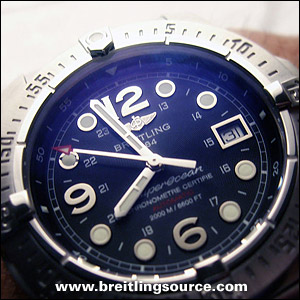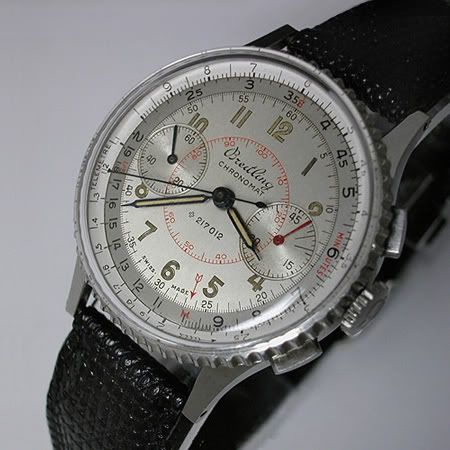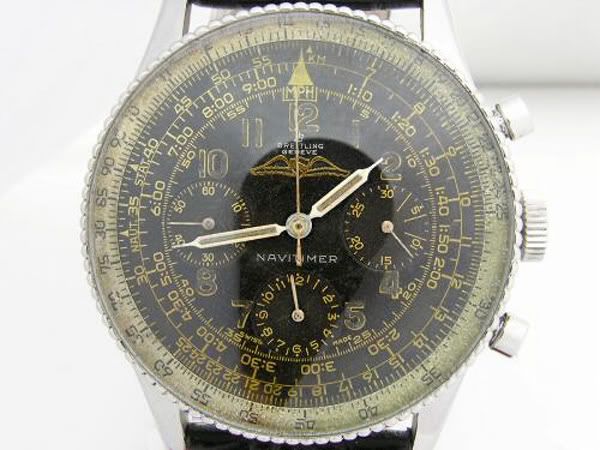Driver8 recently posted his top 10 Breitlings of the modern era in this thread -
viewtopic.php?f=1&t=29313 and there was the challenge to try and come up with an all-time list.
Well I guess I had to respond to that!
There are some inconsistencies between my placing of contemporary pieces and Driver8’s, because I don’t completely agree with his list, and I am sure by expanding this to all time we are opening an even bigger can of worms and I am setting myself up for disagreement. I’ve tried not to box myself into a corner with ‘rules’, but I have consciously avoided very small run obscure LEs and only include LEs at all when they are actually notably different. I have also avoided individual pieces – sure pocket watch #1 is important, but no one knows what it looks like so it’s not on the list.
It’s easier with older pieces to identify the key models because we have the benefit of being able to look back at them, and I am sure that there aren’t too many surprises there, it’s harder with modern pieces, but I have tried to give a nod to importance not just aesthetics.
So without further ado……..
10 – SteelfishIt’s worth remembering that the original (42mm) Steelfish was only introduced in 2005. It evolved rapidly into the iconic timepiece that we recognize today. Would it have made the list if Breitling hadn’t just killed it – yes, I think it would. It’s Breitling’s interpretation of what a diver should be. Sure the Seawolf has greater depth rating, but it’s too big and too heavy (in steel) to move away from niche status. The Steelfish has a practical size and weight with all the depth rating that you realistically need and an incredibly legible dial
 9 – Emergency
9 – EmergencyI guess that some people may be surprised to see a quartz model on my list, but there had to be one. Breitling dominates the quartz chronometer statistics, and their modified ETA superquartz has been hugely successful. The Emergency took that to a whole new level. The earliest were pre COSC, but that soon followed. The Emergency is still a unique standout, an emergency transmitter that can be taken with you wherever you go and that has proven itself. There are a number of people who may not be alive today if not for this watch. If that doesn’t make it worthy of inclusion then I don’t know what does. Add Davey’s (damnfoolman) photography skills into the mix and throw in a UTC and you get this:
 8 – 1940s / 50s Datora Moonphase
8 – 1940s / 50s Datora MoonphaseI struggled with the inclusion of this watch. It is one of the most faked and least well documented Breitlings of this vintage, but it’s also the birthplace of the modern Datora and the modern Olympus models so for that reason I have to include it. Typically it would be a model 799 or 800 (picture is of a 799 that a member posted a while back that I am as convinced about as any of them). This might be the most contentious inclusion in the top 10, but it was the starting point for a lot of modern pieces so has to be there for me.
 7 – Bentley Le Mans
7 – Bentley Le MansDriver8 said most of what I would have to say about this watch when he included it in his top ten. It’s a watch that has to be seen and worn to be appreciated – so maybe some personal bias is entering into it. It just works, it’s an incredible piece that comes together in a unique package that no other Bentley since has been able to achieve. There may never have been a Motors T without the bezel on the Le Mans. Forgive a moment of self-indulgence, but to me the copper dial works really well, especially with the red date – this one’s mine:
 6 – Lemania Cosmonaute with display back
6 – Lemania Cosmonaute with display backI had to include a Cossie on the list, and it was difficult to decide which one. The obvious choice was the original 809 that Scott Carpenter worked with Breitling on, that’s what started it all. For me though the mid-1990s Lemania hand wound version edges it for such a classic movement. If you are going to choose that one then you have to go with the display back version – the Lemania is beautiful, even if some purists were horrified to see the plastic (delrin). Can’t beat Ron’s photos.

 5 – 1984 – 2010 Chronomat
5 – 1984 – 2010 ChronomatI guess that I am cheating a little bit here because this is multiple models, but the DNA from the original 81950 of 1984 clearly carried all the way through to the Evos / Chronomats of the last few years that have so sadly now been retired. This is the watch that re-launched Breitling into the mechanical renaissance, it’s the watch that introduced iconic design cues in the bezel and rider tabs and it’s the watch that became a showcase for that workhorse chronograph movement the Valjoux 7750.
At the same time it showed that Breitling was still at the forefront of aviation timepieces, partnering with the PAN Frecce Tricolori to design the watch. Here’s a shot from Alan Trott’s history of the original 1984 version – a very early piece as evidenced by the lack of the Breitling wings logo:
 4 – Original Chronomat (769)
4 – Original Chronomat (769)I suspect that there are still some people on the site who think that the original Chronomat is from 1984. This piece is seen as the poor relation of the Navitimer, but without the Chronomat there would never have been a Navitimer. It first appeared in 1942 – a feat that is incredible in itself, launching a radically new watch while most production was focused on flight instruments for the allied war effort. The slide rule design and gearing was patented and Breitling were so proud of this they put the patent number (217012) right on the dial. The Navitimer slide rule was of a different design, but the heritage is obvious.
I chose the 769 model number because it is
the iconic Chronomat. There were others that are more appealing to collectors, but this is the classic. Picture from Alan Trott’s history:
 3 – Navitimer B01 LE
3 – Navitimer B01 LEIt’s not the first in house movement watch, but it is the first to showcase the movement with a display back (along with other releases in the same window). I chose this one over the Chronomat B01 because I feel that this is the watch that will determine the success or failure of Breitling as a manufacture. It’s a classic design with some contemporary twists and shows that while Breitling as a company is very different from the company of most of the 20th century they are still capable of producing iconic watches that have timeless appeal. The photo is of dhalem’s piece as I wanted a shot on the Navitimer bracelet:
 2 – Original Chrono-matic
2 – Original Chrono-maticThere is a popular misconception that the Zenith El Primero was the first automatic chronograph. Well calling yourself ‘the first’ might make you think that it was, but it wasn’t. Dig deeper and you will find that the El Primero was unveiled in January of 1969 as a movement only, while Breitling / Heuer / Hamlton / Dubois-Depraz unveiled a completed watch on March 3rd 1969, several weeks before Zenith’s watch was unveiled at Basel. The Breitling was also the first to be in series production by about May / June of 1969.
Well, that’s where the story ends for many people – Zenith had the first movement, Breitling et al had the first watch. Not quite. The photo below is from Navitimer.net and shows the Chrono-matic pre-serie. It was available in September 1968. Game. Set. Match.
 1 – Navitimer 806
1 – Navitimer 806What else could it be really? The watch that defined Breitling for most of the 50s, 60s and 70s and the watch that is the heritage of the iconic pieces we know today. It is still the subject of mystery on the vintage part of the site with the various debates over when the first appeared, the use of different movements, etc. It changed a number of times over its life, but the image I have chosen is the classic first generation – original style hands, beads of rice bezel, all black slide rule and black sub dials. Photo from Alan Trott’s WatchUSeek post:

So there you have it, my personal top ten Breitlings of all time. I’m sure that everyone will disagree with at least one or two, some will probably disagree with most, but as I look at this list it reads like a hall of fame for what Breitling means to
me, and that’s all I can offer.





















